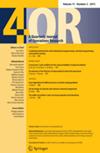Is the best–worst method path dependent? Evidence from an empirical study
IF 2.6
4区 管理学
Q3 OPERATIONS RESEARCH & MANAGEMENT SCIENCE
引用次数: 0
Abstract
Abstract The Best–Worst method (BWM) is one of the latest contributions to pairwise comparisons methods. As its name suggests, it is based on pairwise comparisons of all criteria (or possibly other objects, such as alternatives, sub-criteria, etc.) with respect to the best (most important) and the worst (least important) criterion. The main aim of this study is to investigate the path and scale dependency of the BWM. Up to now, it is unknown whether the weights of compared objects obtained by the method differ when the objects are compared first with the best object, and then with the worst, or vice versa. It is also unknown if the outcomes of the method differ when compared objects are presented in a different order, or when different scales are applied. Therefore, an experiment in a laboratory setting is performed with more than 800 respondents university undergraduates from two countries in which the respondents compare areas of randomly generated figures and the relative size of objects is then estimated via the linearized version of the BWM. Last but not least, the accuracy of the BWM is examined with respect to different comparison scales, including Saaty’s nine-point linguistic scale, an integer scale from 1 to 9, and a continuous scale from 1 to infinity.最佳-最差方法是否依赖于路径?实证研究的证据
Best-Worst method (BWM)是对两两比较方法的最新贡献之一。顾名思义,它基于对所有标准(或可能的其他对象,如替代方案、子标准等)的两两比较,比较最佳(最重要)和最差(最不重要)标准。本研究的主要目的是探讨BWM的路径和尺度依赖性。到目前为止,尚不清楚先与最优对象比较,再与最差对象比较,该方法得到的比较对象的权重是否不同。当比较对象以不同的顺序呈现或应用不同的尺度时,该方法的结果是否会有所不同,这也是未知的。因此,我们在实验室环境中对来自两个国家的800多名大学生进行了一项实验,在实验中,受访者比较了随机生成的数字的面积,然后通过线性化的BWM估计物体的相对大小。最后但并非最不重要的是,BWM的准确性在不同的比较尺度上进行了检查,包括Saaty的九点语言尺度,从1到9的整数尺度,以及从1到无穷大的连续尺度。
本文章由计算机程序翻译,如有差异,请以英文原文为准。
求助全文
约1分钟内获得全文
求助全文
来源期刊

4or-A Quarterly Journal of Operations Research
管理科学-运筹学与管理科学
CiteScore
3.80
自引率
5.00%
发文量
26
审稿时长
6 months
期刊介绍:
4OR - A Quarterly Journal of Operations Research is jointly published by the Belgian, French and Italian Operations Research Societies. It publishes high quality scientific papers on the theory and applications of Operations Research. It is distributed to all individual members of the participating societies.
 求助内容:
求助内容: 应助结果提醒方式:
应助结果提醒方式:


